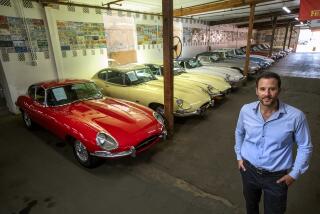The Car That Put Cadillac to Shame
- Share via
A 1934 advertisement in Vanity Fair pictured a well-attired gentleman in his 50s standing on the deck of a schooner, .a gust of wind blowing his necktie and silvery-gray hair straight back. The only copy was at the bottom of the page. It read: He drives a Duesenberg.
No other American car--not Lincoln or Packard or even Cadillac--had so powerful an image.
The Model J Duesenberg, the quintessential American classic, excelled in engineering and design. It was powered by an enormous straight-eight that poured out 265 horsepower in normally aspirated form and a chest-swelling 320 with the supercharged SJ version--fully 100 horsepower better than the closest competitor.
Such power, however, came at staggering price: A Model J chassis sold for $8,500 in 1929. In 1932, when the Depression was hitting its stride, the price was increased to $9,500. With custom coach work, a modestly dressed Duesenberg commanded $15,000, more than twice the price of a custom-bodied V-16 Cadillac.
Southern California was a mecca for Duesenbergs, with dozens of the lengthy Model J chassis fitted with coach work designed and built in Pasadena by the Walter M. Murphy Co. Murphy produced 135 Duesenberg bodies in 14 styles from 1929 to 1932, the most popular being the convertible coupe, of which more than 50 were built.
Given that Duesenberg Inc. built only 485 cars in nine years, one wonders how it could have turned a profit in the Depression-torn ‘30s. The answer, quite simply, was that it didn’t have to. Auburn-Cord-Duesenberg CEO Errett Lobban Cord never had any illusions about Fred and August Duesenberg making money for his automotive empire with their remarkable Model J. Profit was of secondary concern to the Indiana auto maker. Cord asked only one thing of the Duesenberg brothers: Build the world’s finest automobile.
Among affluent Americans, ownership of a Duesenberg took its place alongside lavish estate homes and private yachts as a symbol of success. Such stars as Clark Gable, Gary Cooper, Mae West and Marion Davies owned at least one Model J, as did newspaper publisher William Randolph Hearst, the Vanderbilt and Wrigley families and Woolworth heiress Barbara Hutton.
Today, more than two-thirds of all Duesenbergs built are still in existence. Most are in private collections, but some are on display in museums, including the Petersen Automotive Museum in Los Angeles. Its current exhibition “It’s a Duesy!”--which showcases 17 of the classic vehicles through January--is an opportunity to see cars that roamed the streets of Los Angeles in an era when glamour and stardom were defined not only by who you were but by what you drove.
* Petersen Automotive Museum, 6060 Wilshire Blvd., (323) 930-CARS. Through Jan. 31. Tuesdays through Sundays, 10 a.m. to 6 p.m. Adults, $7; senior citizens and students, $5; children 5-12, $3.
*
Dennis Adler is an author and automotive historian. His latest book, “Packard,” is forthcoming this fall from Motorbooks International.






